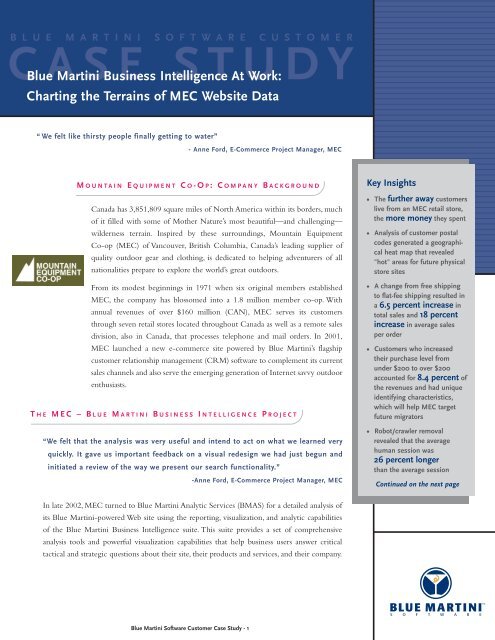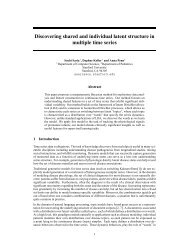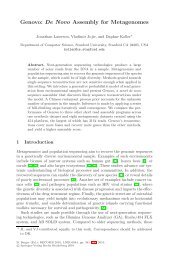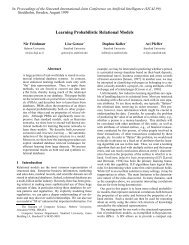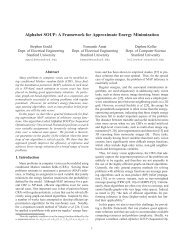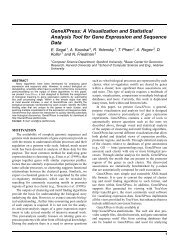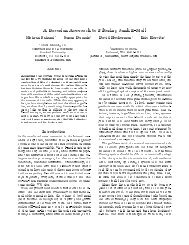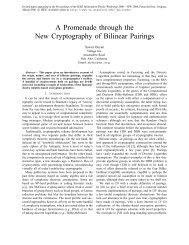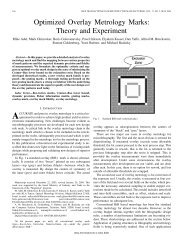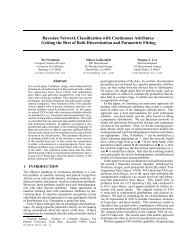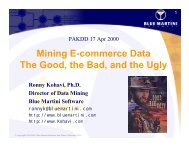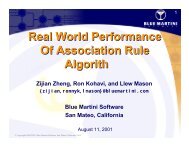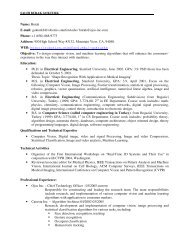Blue Martini Software Customer Case Study
Blue Martini Software Customer Case Study
Blue Martini Software Customer Case Study
Create successful ePaper yourself
Turn your PDF publications into a flip-book with our unique Google optimized e-Paper software.
B L U E M A R T I N I S O F T W A R E C U S T O M E R<br />
CASE STUDY<br />
<strong>Blue</strong> <strong>Martini</strong> Business Intelligence At Work:<br />
Charting the Terrains of MEC Website Data<br />
“We felt like thirsty people finally getting to water”<br />
- Anne Ford, E-Commerce Project Manager, MEC<br />
M OUNTAIN E QUIPMENT C O -OP : COMPANY B ACKGROUND<br />
Canada has 3,851,809 square miles of North America within its borders, much<br />
of it filled with some of Mother Nature’s most beautiful—and challenging—<br />
wilderness terrain. Inspired by these surroundings, Mountain Equipment<br />
Co-op (MEC) of Vancouver, British Columbia, Canada’s leading supplier of<br />
quality outdoor gear and clothing, is dedicated to helping adventurers of all<br />
nationalities prepare to explore the world’s great outdoors.<br />
From its modest beginnings in 1971 when six original members established<br />
MEC, the company has blossomed into a 1.8 million member co-op. With<br />
annual revenues of over $160 million (CAN), MEC serves its customers<br />
through seven retail stores located throughout Canada as well as a remote sales<br />
division, also in Canada, that processes telephone and mail orders. In 2001,<br />
MEC launched a new e-commerce site powered by <strong>Blue</strong> <strong>Martini</strong>’s flagship<br />
customer relationship management (CRM) software to complement its current<br />
sales channels and also serve the emerging generation of Internet savvy outdoor<br />
enthusiasts.<br />
T HE MEC – BLUE M ARTINI B USINESS I NTELLIGENCE P ROJECT<br />
“We felt that the analysis was very useful and intend to act on what we learned very<br />
quickly. It gave us important feedback on a visual redesign we had just begun and<br />
initiated a review of the way we present our search functionality.”<br />
In late 2002, MEC turned to <strong>Blue</strong> <strong>Martini</strong> Analytic Services (BMAS) for a detailed analysis of<br />
its <strong>Blue</strong> <strong>Martini</strong>-powered Web site using the reporting, visualization, and analytic capabilities<br />
of the <strong>Blue</strong> <strong>Martini</strong> Business Intelligence suite. This suite provides a set of comprehensive<br />
analysis tools and powerful visualization capabilities that help business users answer critical<br />
tactical and strategic questions about their site, their products and services, and their company.<br />
<strong>Blue</strong> <strong>Martini</strong> <strong>Software</strong> <strong>Customer</strong> <strong>Case</strong> <strong>Study</strong> - 1<br />
-Anne Ford, E-Commerce Project Manager, MEC<br />
Key Insights<br />
• The further away customers<br />
live from an MEC retail store,<br />
the more money they spent<br />
• Analysis of customer postal<br />
codes generated a geographical<br />
heat map that revealed<br />
"hot" areas for future physical<br />
store sites<br />
• A change from free shipping<br />
to flat-fee shipping resulted in<br />
a 6.5 percent increase in<br />
total sales and 18 percent<br />
increase in average sales<br />
per order<br />
• <strong>Customer</strong>s who increased<br />
their purchase level from<br />
under $200 to over $200<br />
accounted for 8.4 percent of<br />
the revenues and had unique<br />
identifying characteristics,<br />
which will help MEC target<br />
future migrators<br />
• Robot/crawler removal<br />
revealed that the average<br />
human session was<br />
26 percent longer<br />
than the average session<br />
Continued on the next page
MEC provided BMAS with information from its Web site databases, including clickstreams,<br />
transactions, content, product catalog, and customer information. The <strong>Blue</strong> <strong>Martini</strong> team<br />
analyzed the MEC data using <strong>Blue</strong> <strong>Martini</strong>’s Business Intelligence suite and presented a detailed<br />
set of findings to MEC. The presentation featured key insights across a broad range of topics:<br />
• From the geographical distribution of current customers to the characteristics of emerging<br />
customer segments<br />
• From the performance of top-selling products to the predicted performance of yet-untried<br />
product combinations<br />
• From the impact of marketing campaigns to the effectiveness of online search<br />
• From the online browsing behavior of MEC site visitors to the effectiveness of certain pages<br />
(or regions) of the site.<br />
The following sections present some of the key insights gleaned from the MEC data using <strong>Blue</strong><br />
<strong>Martini</strong>’s Business Intelligence suite.<br />
F ROM W HERE D O T HEY C OME?: A GEOGRAPHICAL BREAKDOWN OF MEC<br />
CUSTOMERS<br />
By overlaying Canadian and US latitude-longitude data with customer postal codes, <strong>Blue</strong><br />
<strong>Martini</strong> presented a geographical breakdown of MEC customers in Canada and the US. Most<br />
customers were clustered in regions around the seven MEC retail stores.<br />
<strong>Blue</strong> <strong>Martini</strong> <strong>Software</strong> <strong>Customer</strong> <strong>Case</strong> <strong>Study</strong> - 2<br />
A map showing purchasers’ postal codes,<br />
ranging from gray (no purchasers) to yellow<br />
(few purchasers) to orange and red-hot (many<br />
purchasers); stores are shown in black.<br />
Such maps can help MEC determine the best<br />
locations for new physical stores and help<br />
tune direct mail strategies.<br />
This analysis also helped reveal a related compelling trend: customers living further away from<br />
retail stores tended to place orders of greater value as compared to those that resided closer to<br />
the retail stores.This was despite the fact that the MEC had a flat shipping charge for all orders.<br />
Average revenue<br />
per customer<br />
Total revenue<br />
0 to 20 20 to 60 60 to 100 100 to 200 over 200<br />
Kilometers to Nearest Store<br />
Key Insights (cont)<br />
• Visits that included a search<br />
generated more than twice as<br />
much revenue as visits that<br />
did not; moreover, if the last<br />
search in a session was successful<br />
(i.e., results were<br />
returned), that visit generated<br />
almost three times as much<br />
revenue as visits that included<br />
no search at all<br />
• About one in thirty failed<br />
searches used one of six<br />
keywords<br />
• Revenue per session that<br />
included a view of a "For Your<br />
Information" text, providing<br />
additional product information,<br />
was nearly six times<br />
higher than the average session<br />
• Product affinity analysis identified<br />
significant cross-sell<br />
opportunities that were not<br />
currently offered on the site<br />
• A portion of the site dedicated<br />
to visitors advertising used<br />
products for sale (Gear Swap)<br />
was an island. Revenue per<br />
session that included page<br />
views from this area was<br />
1/4th the revenue of the<br />
average session
W HO ARE THE BEST CUSTOMERS?: MIGRATORS, A PRIME TARGET<br />
MEC’s online customer base includes a group of customers that retailers are starting to identify<br />
and target—the migrators. Migrators represent a group of customers who begin their relationship<br />
with a retailer with a small initial purchase, but significantly increase their spending over time.<br />
<strong>Blue</strong> <strong>Martini</strong> was able to identify a migrator segment within MEC’s customer base, which<br />
migrated from purchase levels under $200 CAD over a six-month period to over $200 CAD in<br />
the following six months. To better understand the behavior of these customers, <strong>Blue</strong> <strong>Martini</strong><br />
performed a detailed characterization of this segment.<br />
A powerful methodology in the study of customer segmentation and customer behavior is the<br />
development of a comprehensive customer signature.The <strong>Blue</strong> <strong>Martini</strong> Business Intelligence suite<br />
enables users to construct rich customer signatures comprising of hundreds of attributes by<br />
combining different sources of information such as purchase history, browsing behavior, and<br />
demographic information. In the case of MEC, over 300 attributes were created in the customer<br />
signature.<br />
The analysis revealed that migrators, based on their first six months as customers, were<br />
likely to:<br />
• Purchase $70 CAD of merchandise or more<br />
• Purchase at least twice<br />
•Have the largest single order be more than $40 CAD<br />
•Live far from an MEC retail store (over 60 aerial kilometers).<br />
• Purchase from the product lines, such socks, t-shirts, and accessories<br />
• Not purchase shoulder bags and child carriers<br />
T O CHARGE ( OR NOT TO CHARGE) FOR SHIPPING?: ANALYSIS OF A<br />
MARKETING PROMOTION<br />
Online retailers often experiment with shipping promotions in a bid to boost sales. In August<br />
2002, MEC discontinued its free shipping promotion and introduced a flat shipping fee of $6 CAD<br />
for any order, anywhere in Canada.The express shipping policy and costs were not changed.<br />
Although the number of orders dropped nearly 10 percent in the two weeks following the change<br />
in the shipping policy (compared to the two weeks prior), the total sales actually went up by 6.5<br />
percent and the average amount per order went up by 18 percent.This indicated that customers<br />
were now more likely to bundle several small orders into a single large order, but that the new<br />
shipping fee did not deter them from ordering altogether.<br />
The following two charts illustrate this interesting trend in customer response to the change in the<br />
shipping policy.The left chart depicts customers who opted for free shipping before the shipping<br />
policy change and also opted for the flat $6 CAD charge after the shipping policy change. The<br />
right chart depicts customers who opted for express shipping in both periods.The reduction in<br />
orders with low amounts is evident from the left chart while the right chart shows a significant<br />
rise in the number of express shipping orders.<br />
<strong>Blue</strong> <strong>Martini</strong> <strong>Software</strong> <strong>Customer</strong> <strong>Case</strong> <strong>Study</strong> - 3<br />
Bot Filtering<br />
The “bot” filtration algorithm<br />
included in the <strong>Blue</strong> <strong>Martini</strong><br />
Business Intelligence tools<br />
ensures that only true human<br />
traffic will be analyzed. Bots are<br />
automated programs, sometimes<br />
called robots and spiders,<br />
launched by search engines, performance<br />
monitoring services,<br />
and other automated programs.<br />
In the case of MEC, bots generated<br />
23 percent of the Web site<br />
sessions. In fact, over 50 unique<br />
bots were identified (each with<br />
multiple sessions). Without filtering<br />
the bots, key performance<br />
indicators will be skewed. For<br />
example, the average session<br />
duration at MEC was 5:42 minutes,<br />
but, after filtering out the<br />
bot traffic, <strong>Blue</strong> <strong>Martini</strong> found<br />
that the average human session<br />
was 7:12 minutes, 26 percent<br />
longer!
Num. <strong>Customer</strong>s (Focus)<br />
Num. <strong>Customer</strong>s (Comparison)<br />
25<br />
75<br />
Standard Shipping Express Shipping<br />
125<br />
175<br />
225<br />
275<br />
Average Sales<br />
325<br />
375<br />
Above 400<br />
Num. <strong>Customer</strong>s (Focus)<br />
Num. <strong>Customer</strong>s (Comparison)<br />
<strong>Blue</strong> <strong>Martini</strong> <strong>Software</strong> <strong>Customer</strong> <strong>Case</strong> <strong>Study</strong> - 4<br />
25<br />
50<br />
75<br />
100<br />
125<br />
150<br />
175<br />
200<br />
225<br />
250<br />
275<br />
300<br />
325<br />
350<br />
375<br />
400<br />
Above 400<br />
Average Sales<br />
The pink curve shows the sales distribution with free shipping, and the blue curve shows the<br />
distribution with flat-fee shipping.<br />
W HICH PRODUCTS SELL WELL TOGETHER?: BUILDING AN EFFECTIVE PRODUCT<br />
RECOMMENDER MODEL<br />
Association rules for market basket analysis gained notoriety when a study claimed that beer and<br />
diapers sell well together. A possible explanation for this seemingly surprising product association is<br />
that men who take care of their babies during sports events often tend to buy beer for themselves and<br />
diapers for their babies.<br />
Jest aside, market basket analysis has been used extensively by retailers to determine effective<br />
cross-sells.The association algorithm in <strong>Blue</strong> <strong>Martini</strong>’s Business Intelligence suite identified over 160<br />
significant product associations for MEC. <strong>Blue</strong> <strong>Martini</strong> was then able to make enhanced cross-sell<br />
recommendations based on the automatically generated association rules to complement the cross-sell<br />
recommendations already in place on the MEC website.<br />
Product Affinities based on the purchase patterns of the MEC site can help develop additional automated cross-sell<br />
recommendations. <strong>Blue</strong> <strong>Martini</strong> found that if a customer bought the product on the left, her or she was likely to buy<br />
the associated product.<br />
Confidence: 37% of people who purchased Orbit Sleeping Pad also purchased Orbit Stuff Sack<br />
Lift: People who purchased Orbit Sleeping Pad were 222 times more likely to purchase the Orbit Stuff Sack compared<br />
to the general population<br />
MEC
W HERE DO THEY GO?: MEC SITE EFFECTIVENESS<br />
Like any retailer with a Web presence, MEC wanted to learn how customers used the site. And in<br />
addition to understanding user behavior, MEC was also curious about the performance of certain site<br />
sections and features.<br />
MEC has invested significant resources into developing a content rich site to support the purchasing<br />
decisions for its members. They were interested in looking at the return on this investment, and<br />
specifically at FYIs—For Your Information pages. Using the built-in Business Intelligence tools, <strong>Blue</strong><br />
<strong>Martini</strong> found that sessions where visitors viewed FYIs had significantly higher conversion rates:<br />
nearly five times the average session conversion rate. Moreover, sessions in which customers viewed at<br />
least one FYI, the average order amount per session was six times higher than the average order<br />
amount for a session in which no FYI was viewed.<br />
Beyond the usual new product presentation and order processing activities, the site also offers visitors<br />
the opportunity to participate in Gear Swap, a large trading marketplace where members of MEC can<br />
post and browse ads for used equipment. Dedicated to an ecologically sound business model, MEC<br />
whole-heartedly supports the exchange and re-use of consumer goods through the Gear Swap section<br />
of its site. Gear Swap is very popular—14 percent of all site visits go directly to Gear Swap. Of this<br />
group, over two thirds leave the site immediately after browsing the section, indicating that used gear<br />
is the primary focus of these visitors. Not surprisingly, the BMAS team found that sessions of users<br />
who visited Gear Swap were not among MEC’s highest-revenue sessions, with a conversion rate well<br />
below the average session. However, given the continued popularity and success of the initiative, it is<br />
clear that MEC is well positioned to leverage the loyalty of these users as well as the brand equity of<br />
the Gear Swap marketplace.<br />
I N SEARCH OF SUCCESS: ANALYZING SEARCH EFFECTIVENESS<br />
In addition to the wealth of data and analysis prepared for MEC, the <strong>Blue</strong> <strong>Martini</strong> team also showed<br />
the retailer how one basic feature, the search engine, can significantly affect site performance and<br />
revenue. From extensive research on Web sites of companies across different industries, <strong>Blue</strong> <strong>Martini</strong><br />
has proven that successful searches convert more visitors into purchasing customers. A visit with a<br />
search is sometimes worth 50 percent more to your company than a visit without a search.<br />
<strong>Blue</strong> <strong>Martini</strong> found that ten percent of all MEC site visits included a product search. Furthermore,<br />
searches were successful 64 percent of the time and resulted in an average order amount per customer<br />
that was more than two times the amount of an order for which no search is performed. Even more<br />
compelling is the finding that when the last search performed in a browsing session was successful, the<br />
customer is likely to spend more than three times the average order amount than if the last search failed<br />
(i.e., returned no results).<br />
Visit<br />
Search<br />
(64% successful)<br />
Avg sale per visit: 2.2x<br />
70%<br />
10%<br />
Last Search<br />
Succeeded<br />
Avg sale per visit: 2.8x<br />
90%<br />
30%<br />
<strong>Blue</strong> <strong>Martini</strong> <strong>Software</strong> <strong>Customer</strong> <strong>Case</strong> <strong>Study</strong> - 5<br />
No Search<br />
Avg sale per visit: $X<br />
Last Search<br />
Failed<br />
Avg sale per visit: 0.9x<br />
MEC
The search effectiveness report presented a detailed list to MEC of failed search terms and suggestions<br />
for additional search terms for inclusion in the site thesaurus. A periodic review of the top failed search<br />
keywords is an effective way for retailers to monitor the latest trends and customer preferences and<br />
stock their product inventories accordingly. One of the top failed searches was “gift certificates.” It is<br />
interesting to note that MEC was initially not offering gift certificates online, but has since made them<br />
available.<br />
M OVING FORWARD WITH B LUE M ARTINI B USINESS I NTELLIGENCE<br />
“ <strong>Blue</strong> <strong>Martini</strong>’s statistical analysis provided useful and relevant information for<br />
setting strategic direction of our website in 2003”<br />
- Peter Robinson, CEO, MEC<br />
<strong>Blue</strong> <strong>Martini</strong> made several recommendations to MEC that go beyond the standard operation of the<br />
MEC website.The key recommendations included:<br />
• Consider a tiered shipping charge based on order amount (for example, free shipping on orders<br />
above $100 CAD)<br />
• Implement tighter interconnection between MEC shopping and the Gear Swap section. MEC is<br />
now implementing this recommendation<br />
• Use the <strong>Blue</strong> <strong>Martini</strong>’s Web site effectiveness measurement functionality to guide site redesign<br />
• Complement existing product recommendations with those automatically identified using<br />
association rules (market basket analysis)<br />
• Use the online site as an experimental laboratory to try out new product offerings and study<br />
customer response to policy changes or marketing promotions<br />
• Continue to invest in the search engine and monitor failed searches for new trends or changes in<br />
customer preferences<br />
• Combine online data with offline data from retail stores to obtain a 360 degree view of the MEC<br />
customer<br />
• Consider adding highly searched products to the product offering<br />
The project presents MEC with a comprehensive report card of its online operations and empowers<br />
the MEC management team to make well-informed decisions on boosting online sales and enhancing<br />
customer satisfaction.<br />
Visit http://www.bluemartini.com/bi or send e-mail to bi-sales@bluemartini.com to learn more about<br />
<strong>Blue</strong> <strong>Martini</strong> Business Intelligence.<br />
<strong>Blue</strong> <strong>Martini</strong> <strong>Software</strong> Inc., 2600 Campus Drive, San Mateo, California 94403, USA<br />
Tel: +650-356-4000 / Fax: +650-356-4001 / www.bluemartini.com<br />
<strong>Blue</strong> <strong>Martini</strong> <strong>Software</strong> Ltd., Venture House, Arlington Square, Downshire Way, Bracknell, Berkshire, RG12 1WA , United Kingdom<br />
Phone: +44 (0)1344 742825 / Fax: +44 (0)1344 742925 / Email: info-europe@bluemartini.com CS027-08-02<br />
Copyright ©2002 <strong>Blue</strong> <strong>Martini</strong> <strong>Software</strong>, San Mateo, California. All rights reserved. All other company names and their associated products are trademarks or registered trademarks of their respective owners.<br />
<strong>Blue</strong> <strong>Martini</strong> <strong>Software</strong> <strong>Customer</strong> <strong>Case</strong> <strong>Study</strong> - 6


